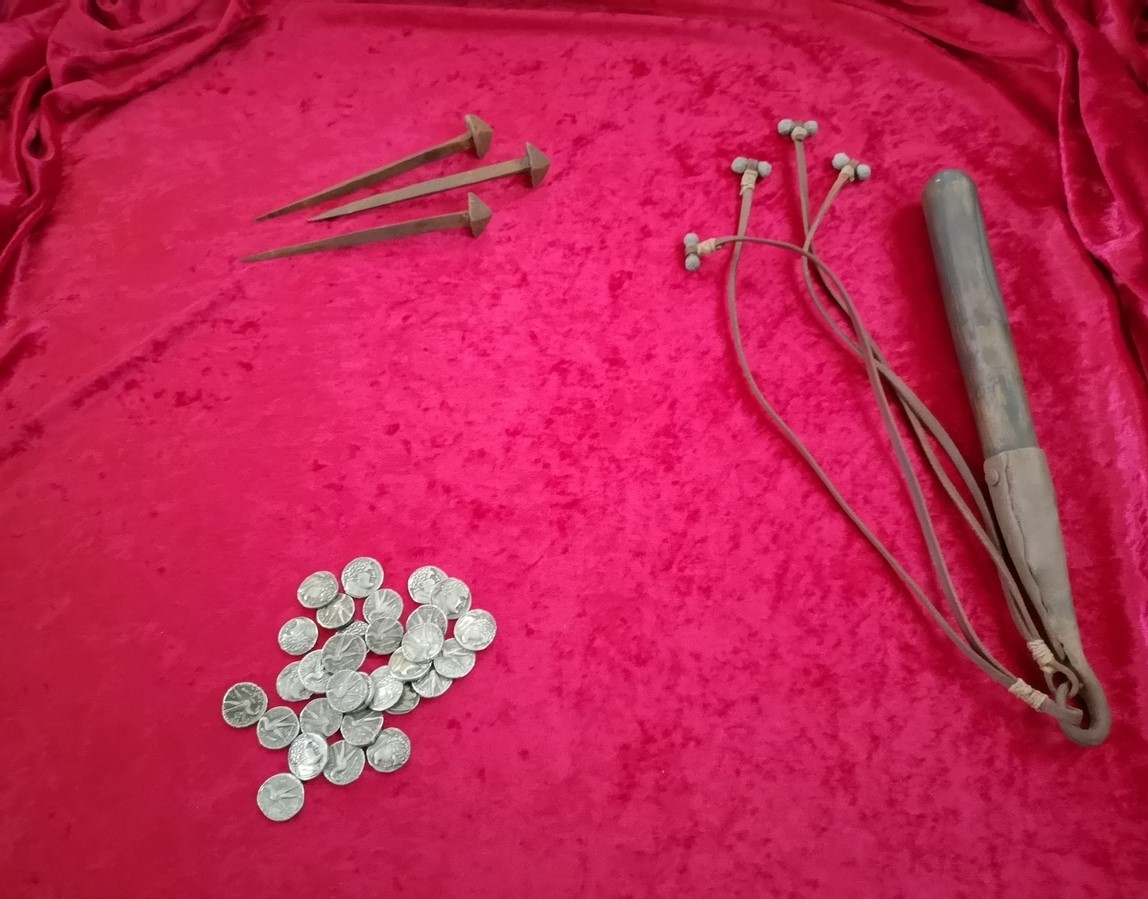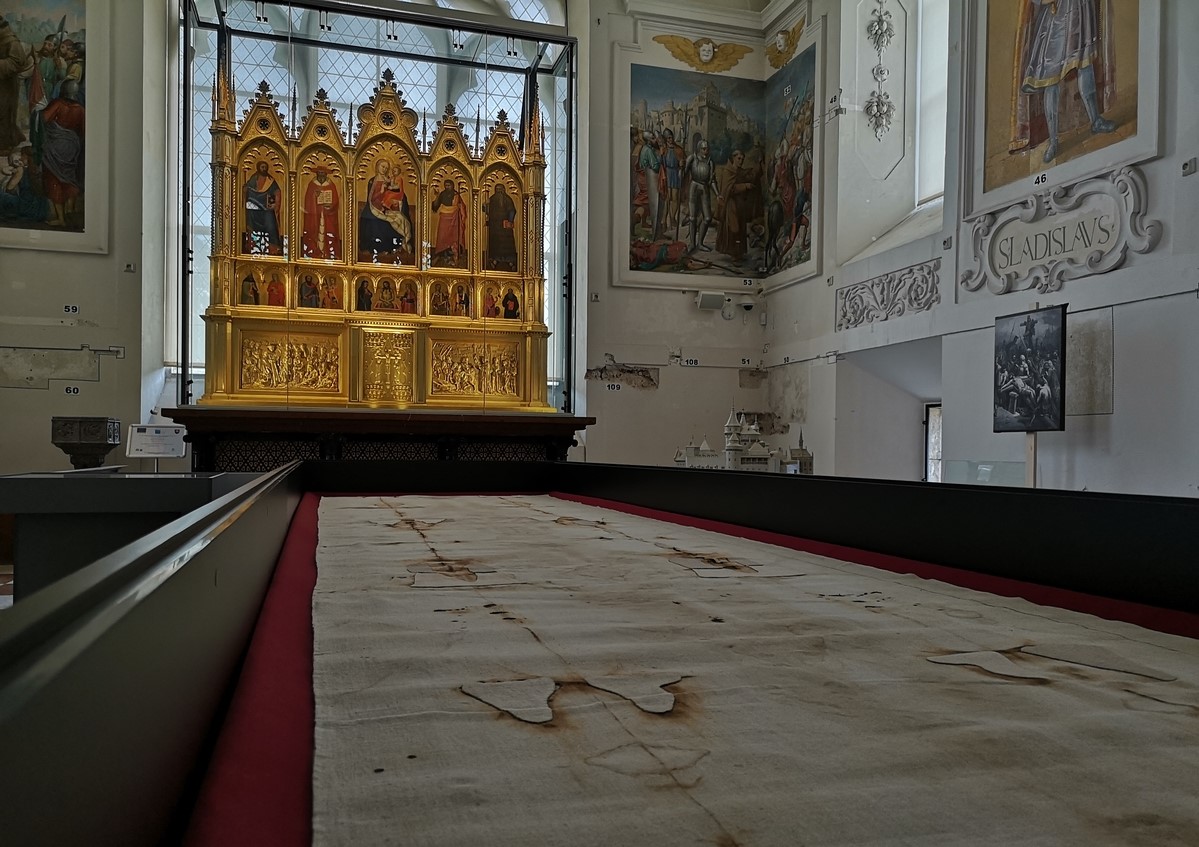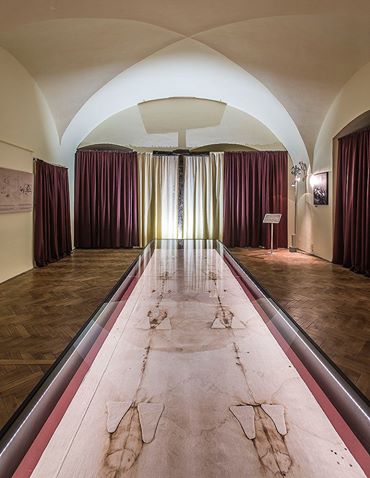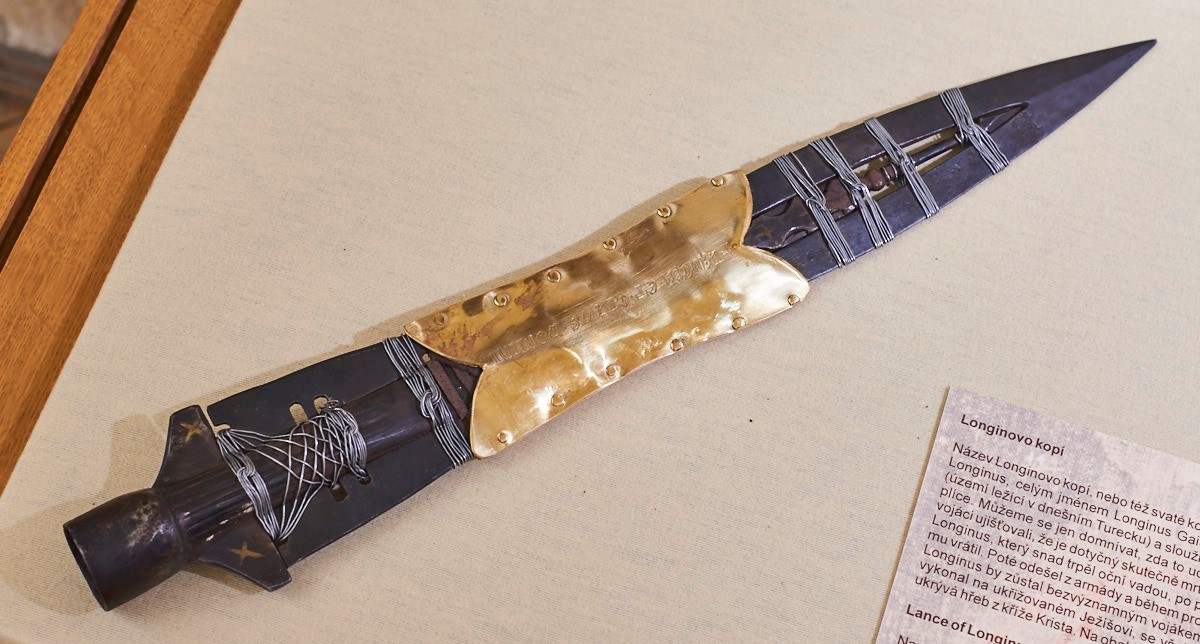

Shroud of Turin
The Shroud of Turin is the burial shroud in which Jesus Christ was wrapped after he was taken down from the cross in 33 AD. Shroud is an incorrect popular name, when shroud is generally referred to as a textile, as the burial shroud was woven with a twill weave. So it's not a shroud. It is a linen twill fabric with dimensions of 436x111 cm, on which you can see the imprint of a male figure about 180 cm tall and 35-40 years old.
The original cloth has been kept since 1578 in the Turin chapel of the Church of St. John the Baptist, from which the name Shroud of Turin also comes. The first mention of the shroud comes from the 13th century, when the cloth was supposed to be in the possession of the Templars. However, there is a contemporary drawing from 1192 that shows identical damage to the Shroud of Turin. It is therefore unlikely that the cloth was made a century later - 1260 to 1390, as determined by the radiocarbon method, but some skeptics refute this.
The cloth was exposed to fire several times and was miraculously not completely destroyed. The largest harm was in December 1532, after which the nuns restored and repaired it.
The cloth was later owned by the de Charny family. After the death of Marquette de Charna in 1460, it was acquired by the Savoy royal family, who bequeathed the robe to the Vatican in 1983.
The Shroud received more attention when the negative of a photo appeared, taken on 5/28/1898 by Italian photographer Secondo Pia, who was the first person in the world to photograph the Shroud of Turin to promote the 400th anniversary celebrations of Turin Cathedral. After developing the negative, for the first time in history, a detailed face print was seen on the robe.
The shroud shows stains where the nails were in the wrist, stains from whipping, but also scars from the crown of thorns, wounds on the face and a side pierced by a spear. All this testifies in favor of the authenticity of the shroud. A group of scientists in the STURP (Shroud of Turin Research Project) had the opportunity to examine the Shroud and take a sample in 1978. Subsequently, a radiocarbon test was carried out, which determined the age of the shroud to be between 1260 and 1390. Apparently, however, a repaired or contaminated part of the shroud was removed and the result cannot therefore be called authentic. After the subsequent repair and conservation of the shroud, when further contamination occurred, it is no longer possible to perform this method again, and the question of the authenticity of the shroud will probably remain a mystery forever.
Skeptics claim that Leonardo Da Vinci could have painted the shroud because he had the knowledge, the ability, the motive and the resources. Until authentic evidence is presented, it is impossible to say with certainty where the truth is, because what is not proven with certainty cannot be disproved.
Regardless of the truth, this is probably the most famous occurrence in the history of humankind, and instead of looking for doubts, it should lead to thinking about human existence, the meaning of life, behavior, respect and respect for values...
Robert Pospíchal, curator of exhibition
The Shroud of Turin is the burial shroud in which Jesus Christ was wrapped after he was taken down from the cross in 33 AD. Shroud is an incorrect popular name, when shroud is generally referred to as a textile, as the burial shroud was woven with a twill weave. So it's not a shroud. It is a linen twill fabric with dimensions of 436x111 cm, on which you can see the imprint of a male figure about 180 cm tall and 35-40 years old.
The original cloth has been kept since 1578 in the Turin chapel of the Church of St. John the Baptist, from which the name Shroud of Turin also comes. The first mention of the shroud comes from the 13th century, when the cloth was supposed to be in the possession of the Templars. However, there is a contemporary drawing from 1192 that shows identical damage to the Shroud of Turin. It is therefore unlikely that the cloth was made a century later - 1260 to 1390, as determined by the radiocarbon method, but some skeptics refute this.
The cloth was exposed to fire several times and was miraculously not completely destroyed. The largest harm was in December 1532, after which the nuns restored and repaired it.
The cloth was later owned by the de Charny family. After the death of Marquette de Charna in 1460, it was acquired by the Savoy royal family, who bequeathed the robe to the Vatican in 1983.
The Shroud received more attention when the negative of a photo appeared, taken on 5/28/1898 by Italian photographer Secondo Pia, who was the first person in the world to photograph the Shroud of Turin to promote the 400th anniversary celebrations of Turin Cathedral. After developing the negative, for the first time in history, a detailed face print was seen on the robe.
The shroud shows stains where the nails were in the wrist, stains from whipping, but also scars from the crown of thorns, wounds on the face and a side pierced by a spear. All this testifies in favor of the authenticity of the shroud. A group of scientists in the STURP (Shroud of Turin Research Project) had the opportunity to examine the Shroud and take a sample in 1978. Subsequently, a radiocarbon test was carried out, which determined the age of the shroud to be between 1260 and 1390. Apparently, however, a repaired or contaminated part of the shroud was removed and the result cannot therefore be called authentic. After the subsequent repair and conservation of the shroud, when further contamination occurred, it is no longer possible to perform this method again, and the question of the authenticity of the shroud will probably remain a mystery forever.
Skeptics claim that Leonardo Da Vinci could have painted the shroud because he had the knowledge, the ability, the motive and the resources. Until authentic evidence is presented, it is impossible to say with certainty where the truth is, because what is not proven with certainty cannot be disproved.
Regardless of the truth, this is probably the most famous occurrence in the history of humankind, and instead of looking for doubts, it should lead to thinking about human existence, the meaning of life, behavior, respect and respect for values...
Robert Pospíchal, curator of exhibition


Copyright © 2017 historické výstavy - všechna práva vyhrazena
Jakékoliv užití obsahu včetně převzetí, šíření či dalšího zpřístupňování článků, fotografií či jiného obsahu je bez předcházejícího písemného souhlasu zakázáno.
Jakékoliv užití obsahu včetně převzetí, šíření či dalšího zpřístupňování článků, fotografií či jiného obsahu je bez předcházejícího písemného souhlasu zakázáno.

Robert Pospíchal
tel.: +420 727 94 54 24
mail: info@historickevystavy.cz
tel.: +420 727 94 54 24
mail: info@historickevystavy.cz
Our partners:
Tips to visit:
Robert Pospíchal ml.
tel.: +420 702 194 933
mail: pospichalr@gmail.com
tel.: +420 702 194 933
mail: pospichalr@gmail.com
muzeum mucicich nastroju
muzeum mučicích nástrojů
muzeum mučicích nástrojů
Exhibition for 2016 - Kroměříž Castle CZE
Shroud of Turin (so-called Sindone di Torino) - the burial shroud in which Jesus Christ was wrapped after death, is the most sacred Christian relic. It is the only faithful copy of the Shroud of Turin in the world, which is made by an international team of experts exactly according to the original and woven using the same method as the original burial shroud.
The exhibition also includes relics related to the crucifixion:
• SPEAR OF LONGRINO • ROMAN FLAGRUM • VEIL OF OVIEDA • CROSS • NAILS
The exhibition is enriched with a lot of visual documentation, where there are historical iconographic drawings and scientific and archaeological photographs, supplemented by texts and explanations. This comprehensive and unique exhibition shows one of the most famous historical events in the history of humankind, which for several millennia and across civilizations evokes emotions, poses questions and seeks answers to the very essence of human existence.
Shroud of Turin (so-called Sindone di Torino) - the burial shroud in which Jesus Christ was wrapped after death, is the most sacred Christian relic. It is the only faithful copy of the Shroud of Turin in the world, which is made by an international team of experts exactly according to the original and woven using the same method as the original burial shroud.
The exhibition also includes relics related to the crucifixion:
• SPEAR OF LONGRINO • ROMAN FLAGRUM • VEIL OF OVIEDA • CROSS • NAILS
The exhibition is enriched with a lot of visual documentation, where there are historical iconographic drawings and scientific and archaeological photographs, supplemented by texts and explanations. This comprehensive and unique exhibition shows one of the most famous historical events in the history of humankind, which for several millennia and across civilizations evokes emotions, poses questions and seeks answers to the very essence of human existence.
..... "art speaks for one, for nations, for humanity".
Exhibition for 2019 - Bojnice Castle SK
The Slovak National Museum-Museum Bojnice will open to the public a unique exhibition entitled Shroud of Turin and the Shroud of Oviedo in the chapel of Bojnice Castle from May 23. The exhibition will present a unique copy of the Shroud of Turin, one of the most revered relics ever. The only copy in the world that was made exactly according to the original, which is located in Turin. The work on the production of the copy lasted almost 5 years. In the end, several dozen people, including experts from universities, worked on the production itself.
The cloth with a width of 111 cm and a length of 436 cm is woven using the traditional method by hand on a loom. Subsequently, it was painted with blood, moistened with water and burned with fire in order to resemble the original as faithfully as possible.
The Slovak National Museum-Museum Bojnice will open to the public a unique exhibition entitled Shroud of Turin and the Shroud of Oviedo in the chapel of Bojnice Castle from May 23. The exhibition will present a unique copy of the Shroud of Turin, one of the most revered relics ever. The only copy in the world that was made exactly according to the original, which is located in Turin. The work on the production of the copy lasted almost 5 years. In the end, several dozen people, including experts from universities, worked on the production itself.
The cloth with a width of 111 cm and a length of 436 cm is woven using the traditional method by hand on a loom. Subsequently, it was painted with blood, moistened with water and burned with fire in order to resemble the original as faithfully as possible.
The Shroud of Turin together with other artifacts will be accessible to the public within the Gallery Circuit of Bojnice Castle.
The exhibition will last at the Archbishop's Castle in Kroměříž throughout the 2016 visitor season. Full entrance fee: 70,-CZK. Reduced entrance fee: 35,-CZK
Special entrance fee at the opening of the exhibition: CZK 35 (entrance fee with a 50% discount during Pilgrimage Days 2016, i.e. Friday and Saturday 18 - 19 March 2016)
Special entrance fee at the opening of the exhibition: CZK 35 (entrance fee with a 50% discount during Pilgrimage Days 2016, i.e. Friday and Saturday 18 - 19 March 2016)
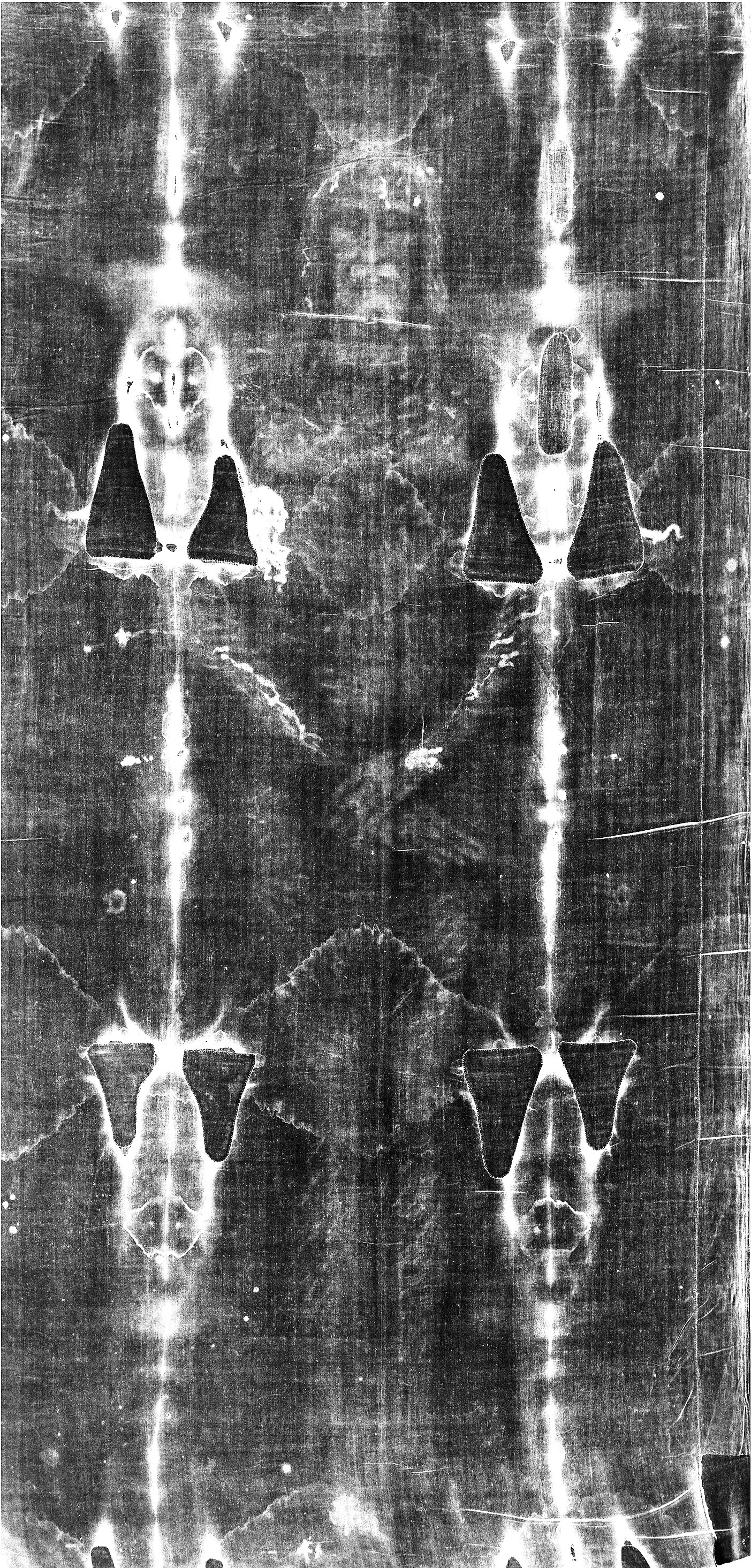

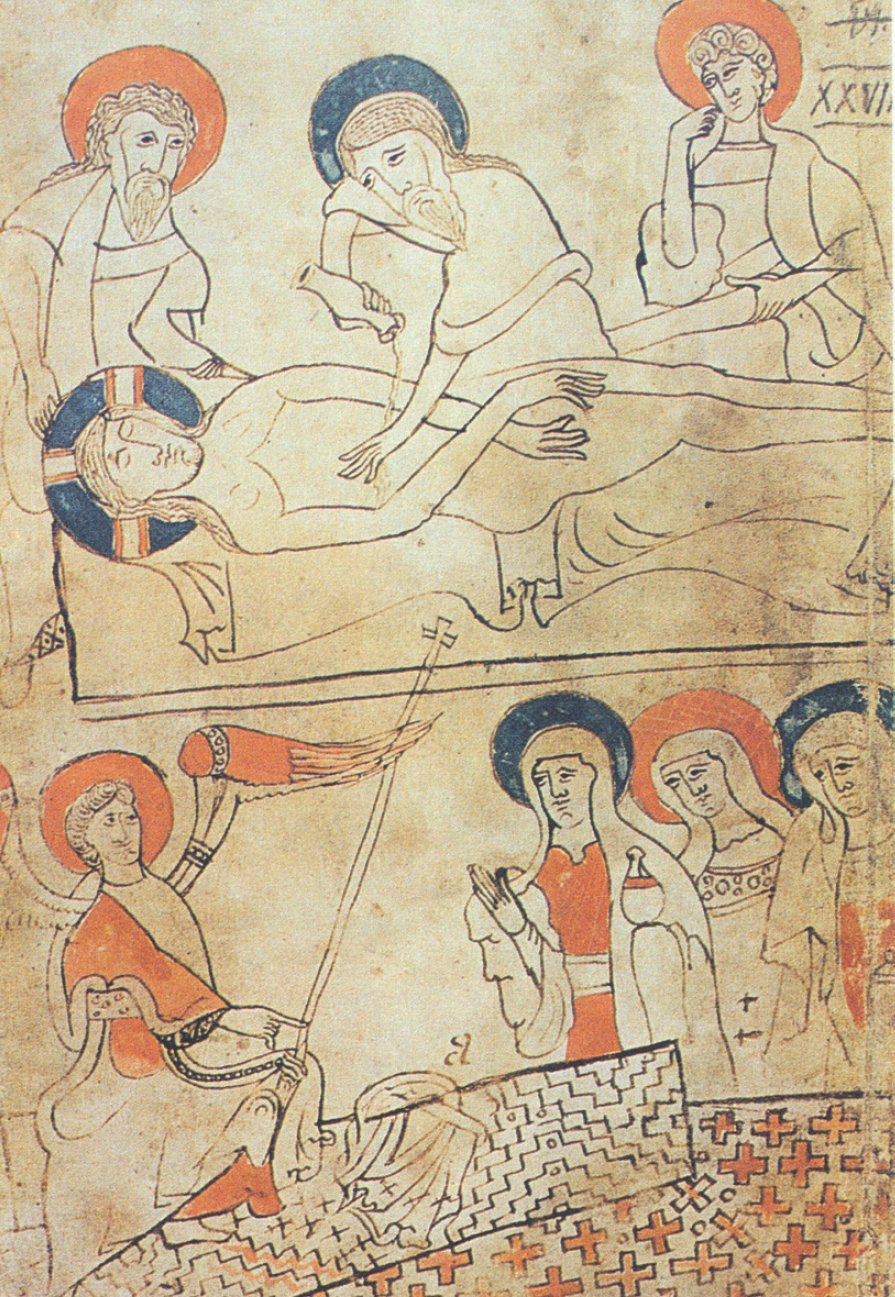














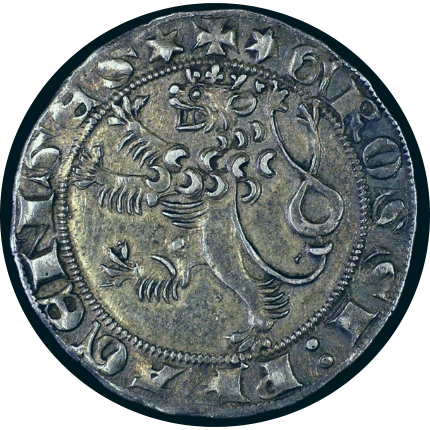
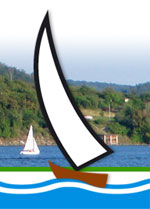






.png)



